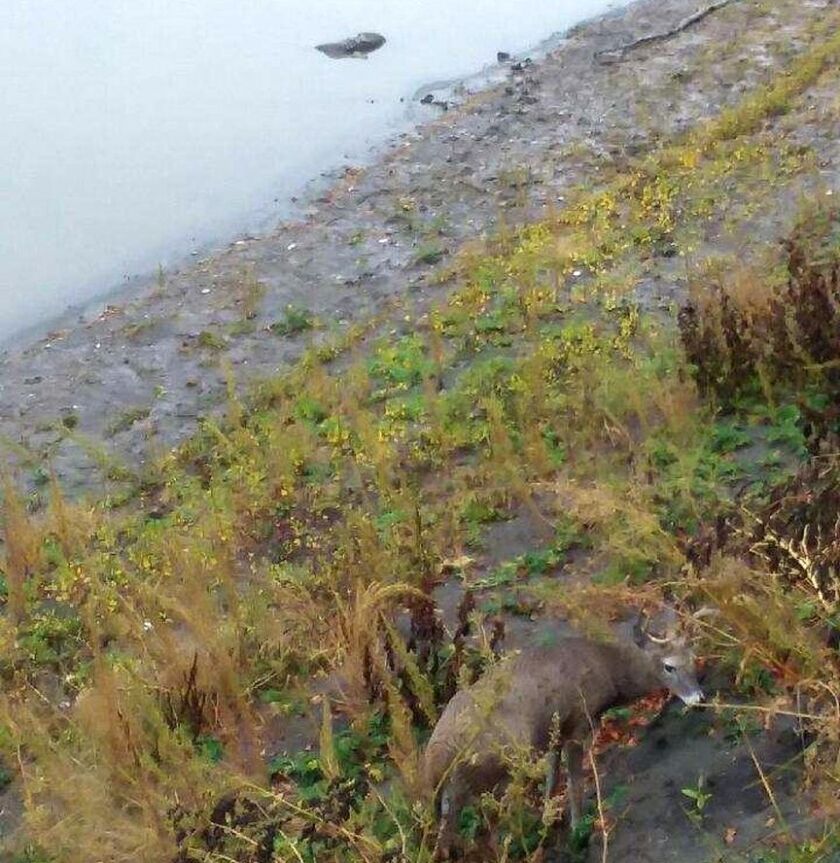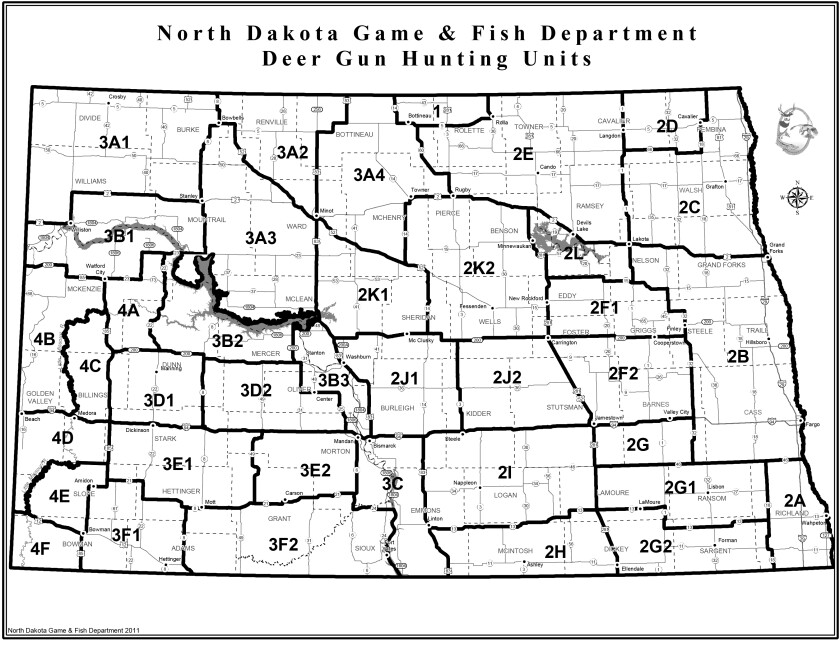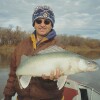NEAR DRAYTON, N.D. – Randy Schuster was out on his family’s property along the Red River south of Drayton a couple of weeks ago when he came across a half-eaten whitetail doe laying in a field.
He didn’t think much of it at the time, but when he and other family members found several more deer the second weekend of October, including an 8-point buck that was still alive but obviously dying, Schuster says he knew something wasn’t right.
“He was just swimming back and forth in the river, and we got within 15 feet of him,” Schuster, of Drayton, said. “I took his picture, and then right behind him in the water was a dead doe floating in the water.”
RELATED STORIES:
- Read more hunting stories in Northland Outdoors
- Read more fishing stories in Northland Outdoors
- Read more recreation stories in Northland Outdoors
The deer dieoff on the Schuster property coincides with the recent discovery of epizootic hemorrhagic disease, a viral illness that afflicts big game animals, which the North Dakota Game and Fish Department has confirmed for the first time in the northern Red River Valley.
ADVERTISEMENT

EHD, a naturally occurring virus that is spread by a biting midge, is often fatal to infected white-tailed deer, while mule deer do not usually die from the disease. EHD incubates for five to 10 days, and most infected deer die within 36 hours of showing symptoms.
The midges, often called "no-see-ums," thrive in stagnant water and wet organic material and can be particularly abundant during drought years. Epizootic, by definition, relates to a disease that is temporarily prevalent and widespread in an animal population.
‘Pretty bad year’
Most of the deer being found in the northern Valley have been too decomposed to test, but Game and Fish personnel were able to retrieve the carcasses from a couple of whitetails and get them to department headquarters in Bismarck for testing.

Blake Riewer, district game warden for the North Dakota Game and Fish Department in Grand Forks, said he has responded to “three or four” separate incidents or reports of dead deer in the past couple of weeks, all within 15 to 20 miles of each other, near or along the Red River east of Grafton, N.D.
ADVERTISEMENT
The reports, which included 25 to 30 deer confirmed dead, have since leveled off, Riewer said.
Statewide, the Game and Fish Department to date has gotten “well over 950” reports from the public of dead deer since late August and has tested more than 50 deer, according to Dr. Charlie Bahnson, wildlife veterinarian for the North Dakota Game and Fish Department in Bismarck.
Once EHD has been confirmed, it’s safe to assume other deer found dead in that area also died from the disease. So far, EHD in the northern Valley doesn’t appear to be as severe and widespread as it is farther west, Bahnson said.

Traditionally, deer hunting units in southwest North Dakota and south of Interstate 94 west of the Missouri River are the hardest-hit areas for EHD, which tends to be worse during drought years, Bahnson said. Reports this year are more widespread and are coming from along the Missouri River both north and south of Bismarck-Mandan, he said.
“This year, it was a little different in that we first had EHD in the Bismarck-Mandan area at the beginning of August and then, unfortunately, things have just only gotten worse since then,” Bahnson said. “Williston started to light up probably late August, and at this point we really have quite a lot of reports from all along the Missouri River. All those units that are adjacent to the Missouri River, basically from our border with South Dakota and our border with Montana, we’ve gotten reports of dead deer.
“It’s been a pretty bad year in North Dakota.”
ADVERTISEMENT
According to Game and Fish, hunters do not have to worry about handling or consuming meat from infected deer because the virus that causes EHD isn’t known to cause disease in humans. EHD tends to surface in late summer and early fall, but the first series of hard frosts typically kills the midge that transmits the EHD virus and will slow or halt the spread of the disease.
Finding multiple dead deer near a water source is typical of an EHD dieoff. Fever drives the animals to seek water, but they die from internal lesions and hemorrhages.
EHD factsheet 2020 by inforumdocs on Scribd
First for northern Valley
The recent cases near Drayton, along with a couple of suspected cases on the Minnesota side of the river in Big Woods Township north of Oslo and Alvarado, are a first for the northern Red River Valley.
“That’s well outside of the traditional EHD area,” Bahnson said. “Really, North Dakota tends to be kind of on the northern fringe of where EHD occurs in North America. There are some reports in Canada, but by and large, we’re kind of on the edge of it, and the northern Valley is especially on the edge of it.”
Especially odd, Bahnson said, is the fact that a large portion of the state between the Missouri River and the Red River has no cases of EHD.
“There’s a heck of a lot of area between where we’re seeing EHD in the majority of the state and that particular spot,” Bahnson said. “It almost looks like a little island of viral activity right now, and it’s, for the most part, kind of a head-scratcher.”
ADVERTISEMENT
In Minnesota, the Department of Natural Resources in September began receiving reports of dead deer in Houston and Winona counties in the southeast part of the state, the agency said – more than 20 in all – and tests from two of the deer in Houston County came back positive for EHD.
The remaining deer were too decomposed to test, the DNR said.
The DNR hasn’t confirmed EHD near Oslo and Alvarado, but Ryan Brown, a DNR conservation officer based in Karlstad, Minn., said he investigated several dead deer near Oslo, adding EHD is suspected as the cause of death. Test results from sampled deer are not yet available, DNR officials said.
As with North Dakota, there’s a huge geographical gap between the suspected EHD cases in northwest Minnesota and the positive cases in southeast Minnesota. Nothing can be done from a management standpoint to mitigate the outbreaks when they occur, the DNR said.
“EHD is both naturally occurring and seasonal,” Dr. Michelle Carstensen, the DNR’s Wildlife Health Program coordinator, said this week in a news release. “We expect the potential for infection to end soon because freezing temperatures kill both the virus and the midge that carries it.”

So far, though, the first hard frost remains elusive. Most years, that happens in mid- to late September in the Grand Forks area, according to the National Weather Service. This year, the area has yet to see a hard frost, and none is on tap through Tuesday, Oct. 19, based on seven-day low temperature forecasts from the NWS.
ADVERTISEMENT
Stench of rotten deer
With North Dakota’s deer gun season just three weeks away – season opens at noon Friday, Nov. 5 – Schuster says he wonders what the season will hold.
The family is fortunate, he says, to also have property along the Red River north of Drayton that has escaped the EHD dieoffs so far. But as of Wednesday, Oct. 13, Schuster says he and other family members have found 13 dead whitetails on their property south of Drayton.
The ravens, vultures and eagles circling the area on both sides of the river tell him there are more.
“You know there’s way more,” Schuster said. “I have this trail camera in what we call the island of trees, and the last two days, the only thing I had on that camera was a bear – no deer.
“The whole time you’re there, you smell rotten deer.”
By comparison, there’d be 10 to 12 deer on the camera every day, including two or three nice bucks, before the die-off began, he said.
The North Dakota Game and Fish Department on Wednesday said it will refund deer licenses for hunters who want their money back in the hardest-hit areas of the state. In a news release Wednesday, the department said refunds will be offered in units 2H, 2I, 2J1, 2K1, 3A1, 3A3, 3B1, 3B2, 3B3, 3C, 3D1, 3D2, 3E1, 3E2, 3F1, 3F2, 4A, 4B, 4C, 4D, 4E and 4F.
Unit 2C, the area along the Red River from Grand Forks to the Manitoba border, isn’t among the units where refunds are being offered, despite the cases of EHD-related dieoffs south of Drayton.
ADVERTISEMENT

“We have not seen a large-enough dieoff to believe it is going to affect the potential hunter success up there, and so that’s why they’re not included in the refund area,” Casey Anderson, wildlife chief for the North Dakota Game and Fish Department in Bismarck, said Wednesday. “The reports that we have heard from that area are coming through our wardens, not even through the public finding dead deer. Usually, if you have enough to start affecting what we would say is hunter success or the ability of hunters to hunt deer in an area because of this issue, the public would be calling in with finding a lot of dead deer, and we’re not seeing that.
“At this point, it’s kind of an anomaly,” Anderson added. “Yeah, there've been a couple that have died of EHD, but it’s not a significant enough amount at this point to warrant refunds in that area because it’s affecting hunters’ ability to hunt deer.”

Still, the dieoffs put a damper on the upcoming deer season, Schuster says.
“It’s a terrible deal,” he said. “You plant your food plots, you get your deer stands ready, and you’re looking forward to hunting and enjoying the hunt.
“I mean, it just makes me sick to my stomach.”









